| Pages:
1
2 |
stamasd
Hazard to Others
  
Posts: 133
Registered: 24-5-2018
Location: in the crosshairs
Member Is Offline
Mood: moody
|
|
ETN question
This is my first attempt to make ETN. After reading extensively many threads here I came up with the following plan:
200g H2SO4 98%
55g NaNO3 (equimolar equivalent of the original 65g KNO3; made the conversion because I have very little KNO3 but plenty of NaNO3)
mix, chill to just above freezing
15g erythritol added in portions with temperature control and stirring
allow to come slowly to RT with stirring, maintain at RT for 30-60min (RT here is around 20C)
Workup for separating ETN etc.
My issue is: even from the first step things didn't go as planned. The 55g NaNO3 do not dissolve in the sulfuric acid completely, even after slow and
careful heating to around 50C. Left outside overnight at close to zero degrees, this morning it had become a solid mass of crystals. I poked at it
with a glass stirrod and the best I could get it without heating is a very thick paste with the consistency of freshly poured concrete. 
I added the E in small portions, stirring that thick paste like crazy with the glass rod; as I added it, the paste became thicker. If I were to
describe it, it's like chunks of compacted snow now.
I'm not sure how to proceed from here, or even if my procedure will work at all.
All your acids are belong to us.
|
|
|
stamasd
Hazard to Others
  
Posts: 133
Registered: 24-5-2018
Location: in the crosshairs
Member Is Offline
Mood: moody
|
|
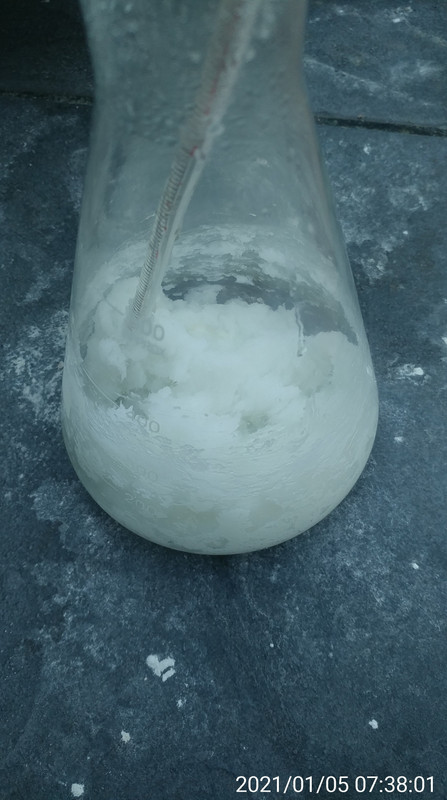
Pic of the mess for reference
All your acids are belong to us.
|
|
|
njl
National Hazard
   
Posts: 609
Registered: 26-11-2019
Location: under the sycamore tree
Member Is Offline
Mood: ambivalent
|
|
How dry is your reaction mixture? Even though part of the reaction is dehydration, I believe you do need at least some water to get everything into
solution. That said, 98% H2SO4 plus the water in your presumably not anhydrous NaNO3 should be enough. Perhaps stirring at RT for longer (or even
slightly higher) will allow the reaction to become self-sustaining. Note, I have no experience with ETN so this could be horrible advice, this is
based on my experience with other nitrate esterifications.
|
|
|
stamasd
Hazard to Others
  
Posts: 133
Registered: 24-5-2018
Location: in the crosshairs
Member Is Offline
Mood: moody
|
|
I've has the mix at RT for about an hour now, it's only slightly thinner but still inappropriate for stirbar. It's like an ice-cream in texture.
Delicious corrosive and explosive ice-cream. 
I'll probably just let it sit at this temperature for another hour or two with occasional manual stirring, then see what I can extract with acetone.
[Edited on 5-1-2021 by stamasd]
All your acids are belong to us.
|
|
|
stamasd
Hazard to Others
  
Posts: 133
Registered: 24-5-2018
Location: in the crosshairs
Member Is Offline
Mood: moody
|
|
I've added 100ml acetone and stirred, the mixture warmed up somewhat and the acetone layer took a yellow color, presumably from NO2. It didn't go
above 30C though. I'll let it sit for another hour with stirring, then see what I've extracted.

(BTW that is a broken thermometer that I've simply repurposed as a stir rod  ) )
[Edited on 5-1-2021 by stamasd]
All your acids are belong to us.
|
|
|
stamasd
Hazard to Others
  
Posts: 133
Registered: 24-5-2018
Location: in the crosshairs
Member Is Offline
Mood: moody
|
|
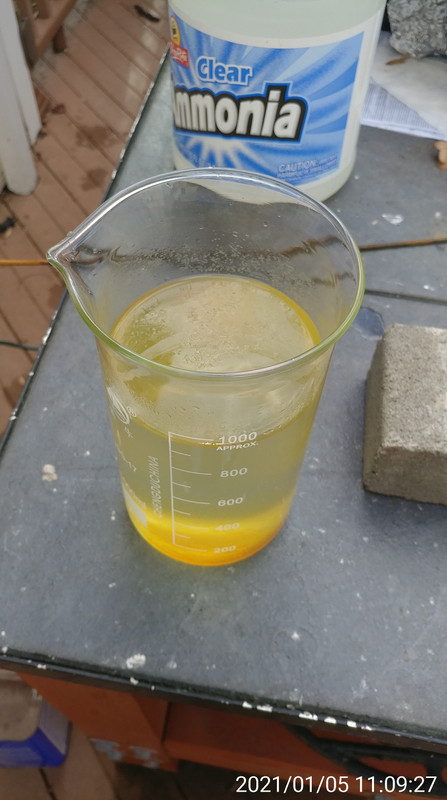
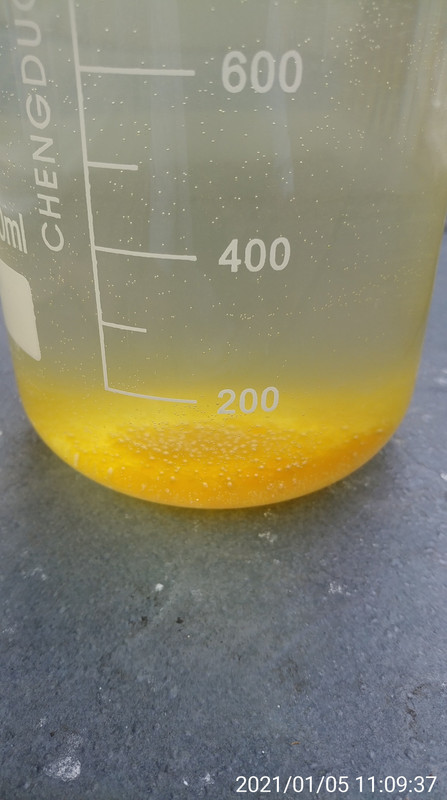
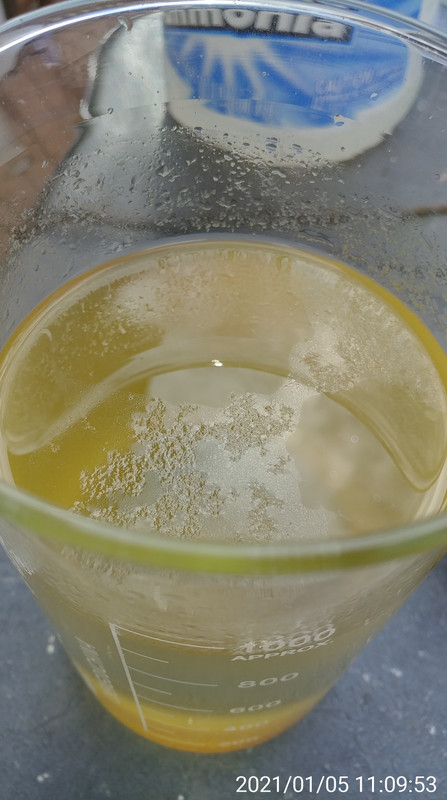
I've mixed the 100ml acetone extract with 800ml cold water; a heavy dark orange oil separated at the bottom, with a thin layer similar in appearance
floating at the top. Doing a second extraction now.
All your acids are belong to us.
|
|
|
greenlight
National Hazard
   
Posts: 705
Registered: 3-11-2014
Member Is Offline
Mood: Energetic
|
|
Ive never used salts only mixed acids except one time when I was a teenager but I shall try and help.
The sulfuric acid and sodium nitrate react to give your nitric acid and sodium sulfate which can further react to sodium bisulfate depending on
conditions.
First, the consistency. You could have added some excess sulfuric acid to thin everything and make a more easily stirred solution. Having excess
within reason can't harm anything and the extra dehydrating power on hand would be helpful.
I dont know why you tried to extract with acetone. I know the ETN is soluble in it but it's a polar ketone which isn't going to form a seperate layer
for you to pull, which isn't advantageous.
Pouring the whole mixture into ice water would have been more beneficial as the salts would be soluble but the ETN would be insoluble and crash out
for you to filter. Then you could recrystallize to remove trace acidity afterwards.
The only use for an atomic bomb is to keep somebody else from using one.
George Wald
|
|
|
njl
National Hazard
   
Posts: 609
Registered: 26-11-2019
Location: under the sycamore tree
Member Is Offline
Mood: ambivalent
|
|
At least using acetone you can leave behind most of the solids. I don't think the idea was to pull of a separate layer, just to wash with a suitable
solvent and then dilute those washings with cold water.
|
|
|
Fyndium
International Hazard
    
Posts: 1192
Registered: 12-7-2020
Location: Not in USA
Member Is Offline
|
|
Speaking reagent-wise, how much would it be possible to reduce the amount of sulfuric acid used in nitration reactions? Would using it first to
generate HNO3 and then making a nitration solution be a more efficient way?
Apparently a resulting slurry is not an issue for that matter sodium salts are water soluble while the desired compound is not.
|
|
|
njl
National Hazard
   
Posts: 609
Registered: 26-11-2019
Location: under the sycamore tree
Member Is Offline
Mood: ambivalent
|
|
Using HNO3/H2SO4 is generally preferable to (X)NO3/H2SO4, but in both cases sulfuric acid is needed. Nitric acid alone does not achieve the desired
result, in part because there is no dehydrating agent. However, H2SO4 apparently participates in the reaction as more than a dehydrating agent.
|
|
|
Fyndium
International Hazard
    
Posts: 1192
Registered: 12-7-2020
Location: Not in USA
Member Is Offline
|
|
The dehydration part I'm aware of and I was about to ask actually could some sort of dehydrating agent be used apart/aside from it, hypothetically?
The reaction mixture in this concept would most likely be closer to concrete than syrup, but aggressive agitation could take care of it. In this
instance, sulfuric acid would be used more as a catalyst amount, unless it chemically reacts alongside the reaction? It is very likely, though, this
wheel would have been invented in the industry already if it worked.
Note: I've read about energetics over a decade ago, so I'm pretty out here and it hasn't been one of my areas of interest in chemistry more than a
small period during those times.
[Edited on 5-1-2021 by Fyndium]
|
|
|
njl
National Hazard
   
Posts: 609
Registered: 26-11-2019
Location: under the sycamore tree
Member Is Offline
Mood: ambivalent
|
|
I believe phosphoric acid also works as an acid catalyst. As far as I know, an acid is needed to protonate HNO3 which then dehydrates to NO2+, the
active electrophile. I think sulfuric acid is generally used because it is cheap and doesn't damage glass (unlike phosphoric acid).
|
|
|
Brightthermite
Hazard to Others
  
Posts: 127
Registered: 26-6-2019
Member Is Offline
|
|
I have had this problem using AN before. If you allow the mix to freeze it never really acts right afterward until it is back to well above room temp
and mixed again. Use more acid and do not allow the acid/salt mix to get so cold.
|
|
|
stamasd
Hazard to Others
  
Posts: 133
Registered: 24-5-2018
Location: in the crosshairs
Member Is Offline
Mood: moody
|
|
Yeah, I used acetone to get rid of the solids and not have to deal with them. Also avoided any undue temperature spikes which would have happened if I
tried to dilute the mix directly with water, even ice water. Fortunately I have access to cheap good quality sulfuric acid in large amounts, so it's
reasonable to use more next time for fluid management reasons. 
For now, it looks like the brown oil on the bottom is slowly solidifying, and as I stir is I see clouds of small needle-like white crystals in the
water which I think are the ETN. I'll let it sit until tomorrow and reevaluate.
All your acids are belong to us.
|
|
|
stamasd
Hazard to Others
  
Posts: 133
Registered: 24-5-2018
Location: in the crosshairs
Member Is Offline
Mood: moody
|
|
I also think that the sodium nitrate acts very differently in these conditions from potassium nitrate for some reason. I'm able to nitrate cellulose
easily with KNO3/H2SO4, but a couple of times when I used NaNO3 instead I ran into the same problem, which led me to heat the mixture, and that caused
a whole mess because the cotton ended up being hydrolyzed by the acid not just nitrated and I ended up with no solid product. I should really get some
KNO3 instead. I know it behaves much better.
It's just that... I have 25 pounds of NaNO3 and I'm trying to find a better use for it than just distill it all into HNO3. 
[Edited on 5-1-2021 by stamasd]
All your acids are belong to us.
|
|
|
greenlight
National Hazard
   
Posts: 705
Registered: 3-11-2014
Member Is Offline
Mood: Energetic
|
|
Quote: Originally posted by stamasd  | Yeah, I used acetone to get rid of the solids and not have to deal with them. Also avoided any undue temperature spikes which would have happened if I
tried to dilute the mix directly with water, even ice water. Fortunately I have access to cheap good quality sulfuric acid in large amounts, so it's
reasonable to use more next time for fluid management reasons. 
For now, it looks like the brown oil on the bottom is slowly solidifying, and as I stir is I see clouds of small needle-like white crystals in the
water which I think are the ETN. I'll let it sit until tomorrow and reevaluate.
|
Ahh I see.
As long as the final product is insoluble in water the volume of ice water that it is poured into doesn't matter (as long as you're not doing gravity
filtering I guess aha). Also the speed it is poured makes a difference. I did a large batch of nitrourea last week which involved quenching 300ml of
98% sulphuric acid solution. I used about a litre of ice water slurry and there wasn't much temp spike.
Might have to do a run with the KNO3 to see if that helps, it's a shame about the NaNO3 being a nuisance during nitration.
Good luck with the work up, hopefully you get some nice white explosive at the end.
The only use for an atomic bomb is to keep somebody else from using one.
George Wald
|
|
|
Fyndium
International Hazard
    
Posts: 1192
Registered: 12-7-2020
Location: Not in USA
Member Is Offline
|
|
Quote: Originally posted by stamasd  | I also think that the sodium nitrate acts very differently in these conditions from potassium nitrate for some reason.
It's just that... I have 25 pounds of NaNO3 and I'm trying to find a better use for it than just distill it all into HNO3.  |
Possibly it has to do with hygroscopicity? Sodium nitrate and resulting sodium sulfate are both highly hygroscopic, while potassium ain't.
You could metastasize it by dissolving potassium salt and sodium salt in equimolar concentrations and crystallizing out the KNO3. For purifying any
nitrate for reagent use, KNO3 is probably one of the best ways to do it, as it crystallizes highly pure with good yields (from 4kg/L to 130g/L
100-0C). Taking the co-precipitation into consideration eats some yields, but is order of magnitude cheaper than turning it into HNO3 (and further
re-reacting it into nitrate).
|
|
|
stamasd
Hazard to Others
  
Posts: 133
Registered: 24-5-2018
Location: in the crosshairs
Member Is Offline
Mood: moody
|
|
Well considering that I was planning to use that NaNO3 as a poor-mans-substitute for HNO3, which it does not do very well - I may as well keep making
nitric acid out of it. Getting RFNA is actually quite straightforward using that material so it won't be wasted. 
(FWIW if anyone's wondering about my cheap/pure H2SO4, the brand "Liquid Lightning" of drain cleaner which I get at my local Wal-Mart is quite pure
and close to 98%, no dyes or other crap - I've had it analyzed; in particular it has close to zero iron contamination. And at $15 per 1/2 gallon, it's
not expensive either)
All your acids are belong to us.
|
|
|
stamasd
Hazard to Others
  
Posts: 133
Registered: 24-5-2018
Location: in the crosshairs
Member Is Offline
Mood: moody
|
|
Quote: Originally posted by Fyndium  |
Possibly it has to do with hygroscopicity? Sodium nitrate and resulting sodium sulfate are both highly hygroscopic, while potassium ain't.
|
That's probably it, especially considering that my sulfuric acid doesn't have much water in it to begin with (see post above)
I'll experiment with adding some water to my sodium-based nitrating mix, probably not enough to get the sodium sulfate all the way to the decahydrate
but at least part of the way there - and see if that improves its properties.
e.g 200g H2SO4, 55g NaNO3 and 30g H2O which would provide 1/2 of the water necessary for the Na2SO4*10 H2O, and go from there
[Edited on 6-1-2021 by stamasd]
All your acids are belong to us.
|
|
|
stamasd
Hazard to Others
  
Posts: 133
Registered: 24-5-2018
Location: in the crosshairs
Member Is Offline
Mood: moody
|
|
Attempting the nitration again, this time with added water. 30g water in the mix didn't really do anything, but with 60g I ended up with a mostly
liquid mix, with some residual solid at the bottom - which didn't solidify when kept at zero degrees overnight. A lot more manageable than before. Of
course, I don't know if nitration occured in this more diluted mix, but it should have at least partially. I'll stir it at room temperature for an
hour or so, then dilute directly the supernatant in cold water. I'll process the solids at the bottom separately, just in case there's any product
hiding in there.
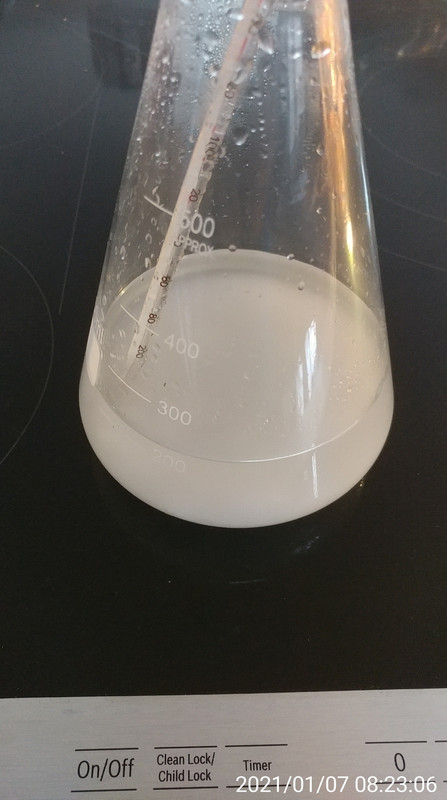
All your acids are belong to us.
|
|
|
stamasd
Hazard to Others
  
Posts: 133
Registered: 24-5-2018
Location: in the crosshairs
Member Is Offline
Mood: moody
|
|
(and as a side note, does anyone have a good source for resorcinol? I'd like to play with some styphnic acid, but can't find any resorcinol on sale
anywhere, and I'd rather not have to produce it myself)
Edit: I found resorcinol for sale on alibaba, I had to order 1kg as that was the minimum order quantity even though it's a LOT more than what I
needed, but the price was OK even with shipping charges from China.
[Edited on 7-1-2021 by stamasd]
All your acids are belong to us.
|
|
|
stamasd
Hazard to Others
  
Posts: 133
Registered: 24-5-2018
Location: in the crosshairs
Member Is Offline
Mood: moody
|
|
Quick update, no pics. I've decanted the liquid portion in a large amount of ice-cold water, nothing precipitated. I added cold water over the
remaining solid stuff as well and stirred until dissolved, nothing left behind. So it looks like no ETN was formed. Maybe some lesser nitrated
congeners which are water-soluble.
In conclusion, NaNO3 is not good for this purpose. I'll attempt it again later with KNO3 instead. The NaNO3 will be reserved for making RFNA when I
need it. 25lbs means a LOT of RFNA though. 
All your acids are belong to us.
|
|
|
Herr Haber
International Hazard
    
Posts: 1236
Registered: 29-1-2016
Member Is Offline
Mood: No Mood
|
|
There is a more obvious conclusion: water is not good.
The spirit of adventure was upon me. Having nitric acid and copper, I had only to learn what the words 'act upon' meant. - Ira Remsen
|
|
|
macckone
International Hazard
    
Posts: 2159
Registered: 1-3-2013
Location: Over a mile high
Member Is Offline
Mood: Electrical
|
|
Using sulfuric acid as a solvent seems like the solution.
Pun intended.
Extracting the final mix with acetone is just asking for trouble since it likes to do condensation reactions with itself in acidic conditions.
If you have the apparatus using the RFNA is better.
Using a salt with sulfuric acid is a work around for not having concentrated nitric acid or the equipment to make it properly.
|
|
|
stamasd
Hazard to Others
  
Posts: 133
Registered: 24-5-2018
Location: in the crosshairs
Member Is Offline
Mood: moody
|
|
Using H2SO4 + KNO3 worked just fine. I got a yield of 93% vs erythritol.
All your acids are belong to us.
|
|
|
| Pages:
1
2 |